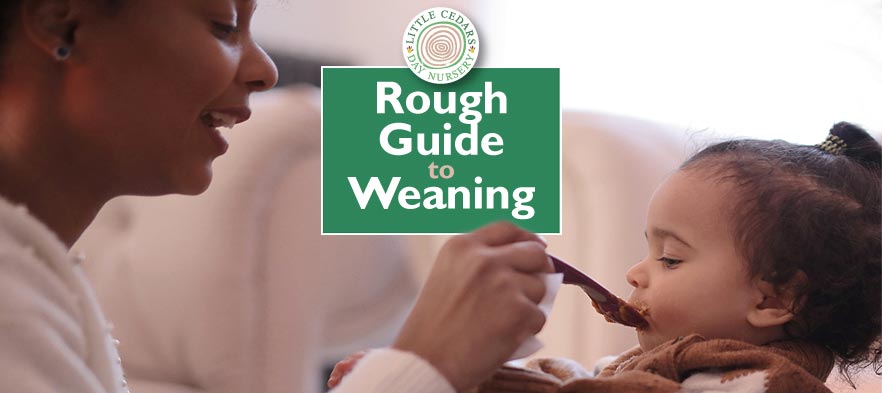
The Cambridge Dictionary defines weaning as “the act or process of causing a baby or young animal to stop feeding on its mother’s milk and to start eating other food.” It’s all about babies moving from a liquid, milk-only diet to a more varied diet that includes “solid” foods (albeit usually mashed or blended initially).  Also known as complementary feeding, weaning is an important milestone for any parent or baby and usually occurs when the baby reaches the age of about 6 months. Sometimes babies simply tire of milk and weaning thereby comes naturally. In other cases, a baby needs a bit more encouragement to make their transition towards solids. Here, we’ll explore the whole topic of weaning in more detail, including ways parents can help to make the transition smoothly and stress-free for all parties.
Also known as complementary feeding, weaning is an important milestone for any parent or baby and usually occurs when the baby reaches the age of about 6 months. Sometimes babies simply tire of milk and weaning thereby comes naturally. In other cases, a baby needs a bit more encouragement to make their transition towards solids. Here, we’ll explore the whole topic of weaning in more detail, including ways parents can help to make the transition smoothly and stress-free for all parties.
How to Help the Weaning Process
First off, parents must realise that weaning is a gradual process i.e. there is a period of overlap where baby continues to drink milk and starts eating other foods. Usually, he or she will gradually eat a greater proportion of solids and less and less milk as time goes by, as opposed to suddenly changing from one to the other in one huge leap. So, weaning is a process, not a single step.
Moving to solid food can be exciting, surprising, confusing, hideous or anything in between for the baby. The world of textured food and new flavours is a whole new experience for baby; each mouthful can represent an explosion of new flavours, textures and adventure. This can be wonderful, or sometimes troubling to the child, depending on the individual and, of course, the tastes and textures involved. Therefore, starting slowly with tiny steps is fine; it’s OK if the baby does not want to eat much at first. They’ll gradually catch on as they get used to this brand new concept.
It’s OK if the baby does not want to eat much solid food at first. They’ll gradually catch on as they get used to this brand new concept.
 Weaning should be fun and it’s also the only time in a child’s life where they won’t have any preconceived ideas about what foods they “do or don’t like”. So, parents can experiment, within reason of course. It’s a time when introducing new foods to the baby comes naturally once the baby has caught on to the idea of this new experience.
Weaning should be fun and it’s also the only time in a child’s life where they won’t have any preconceived ideas about what foods they “do or don’t like”. So, parents can experiment, within reason of course. It’s a time when introducing new foods to the baby comes naturally once the baby has caught on to the idea of this new experience.
Remember that the baby will take a few tries before they perfect the art of eating solid foods, so they may unwittingly push some food out again at first. Until now, they have only been used to breastfeeding or drinking from a bottle, so pushing food out their mouths initially may not mean that they don’t like what you’re feeding them. Give it another try. You’ll be able to ‘read’ their facial expressions anyway. Those are the real giveaway as to whether they enjoy a particular food, or find it repulsive. Their reactions can also be the cause of much laughter!
Tips For Weaning Success
There are several additional things parents can do to make weaning a success. Here are a few tips:
 Don’t rush it; set aside some time with baby so it’s relaxed, otherwise everyone can get stressed, especially initially.
Don’t rush it; set aside some time with baby so it’s relaxed, otherwise everyone can get stressed, especially initially.- Don’t try to wean them off breast milk too soon either. It’s the very best food for them during their first 6 months, for sure. You can learn more in our separate article all about the benefits of breastfeeding for both baby and mother.
- Don’t try to wean your baby until it’s physiologically ready. That means they need to be able to hold their own head up when in a seated position, they need to be able to swallow food successfully and they need to have good coordination between eyes, hands and mouth.
- Is baby tired? Don’t try introducing them to solid foods right now if so. Wait until they’re wide awake and full of energy otherwise they simply won’t want to cooperate.
- Purée (i.e. finely blend or mash) the foods, mashing them particularly well at the start of the weaning process. That way the solid foods are more like liquids, so will be less of a surprise to the baby bearing in mind they’ve only had milk up until this point. Try mashing ripe apples, bananas, pears and other soft fruits, then feeding them to baby with a weaning teaspoon (these are softer and more gentle in babies’ mouths). Try mashing cooked vegetables too, for example cauliflower, potato, broccoli, spinach, sweet potato, carrots and so on. Suitably cooled down for safety, of course. All of these can make a very good purée that’ll slip down easily if the baby warms to the taste.
- Offer baby just a little initially. They’ll soon let you know if they would like more. If they’re not convinced, demonstrate yourself eating a little bit and showing that you’re enjoying it.
- Initially, you can follow a little bit of food up with a milk feed. This is a great way to introduce them slowly to solids.
- Once they’re taking food from you, help them feed themselves either by hand or with a teaspoon (let them copy you). The skill of feeding themselves sometimes comes quite quickly but for others it can take more time.
- Don’t worry if baby makes a mess. It’s natural at first and not something they should concentrate on initially. The important part is that the baby is beginning to try new foods, so you don’t want to distract from that. Coaching baby to be more tidy with their eating can come a bit later, after they’ve mastered the process of eating purées, mashed food and perhaps gone on to more solid food. A clean, plastic or pelican bib will help in the interim.
 You can later move on to whole, (adult) finger-sized pieces of very soft fruits that baby can learn to hold. However, do read the Health & Safety Considerations section below before moving to un-mashed foods.
You can later move on to whole, (adult) finger-sized pieces of very soft fruits that baby can learn to hold. However, do read the Health & Safety Considerations section below before moving to un-mashed foods.- Remember that babies may need to taste new foods multiple times before they accept them, so don’t give up if they first reject them. Try again another time and don’t ever force them to eat. If they turn their head away or clamp their mouth shut, they’ve had enough for now.
- Avoid distractions for the baby at feeding times. So, remove phones, tablets, computers, toys and TVs at meal times. The baby needs to concentrate during this new eating experience.
- Don’t expect a regular pattern; sometimes babies will eat more, other times less. A milk bottle will, for many, represent a comforter as well as a source of sustenance, so don’t be surprised if they prefer milk to solids when they’re feeling under-par or tired.
Huge care needs to be taken to avoid giving infants anything that’s going to represent a potential choking hazard.
Going Forwards
By the age of 7 to 12 months, most babies will have transitioned to taking in 3 meals a day, along with their milk perhaps 4 times a day (reducing to 3 times a day at a year old). The ratio of solids to milk will then gradually decrease as the weeks go by. By the time they’re 12 months or older, they can also have two healthy snacks between meals.
 Always try to maintain a varied diet for the infant, so they get all the vitamins and nutrients they need as they intake less and less milk. Ensure the foods contain sufficient iron, which can be sought from fortified cereal, fish, milk, dark green vegetables, lentils and beans. Giving them finger foods to hold and eat themselves is a great way to encourage them to feed themselves (under supervision, of course). As they grow older they can be encouraged to eat at the family table with parents/siblings and eventually upskill to using cutlery, along with eventually learning the rules around good table manners etc.
Always try to maintain a varied diet for the infant, so they get all the vitamins and nutrients they need as they intake less and less milk. Ensure the foods contain sufficient iron, which can be sought from fortified cereal, fish, milk, dark green vegetables, lentils and beans. Giving them finger foods to hold and eat themselves is a great way to encourage them to feed themselves (under supervision, of course). As they grow older they can be encouraged to eat at the family table with parents/siblings and eventually upskill to using cutlery, along with eventually learning the rules around good table manners etc.
We hope that you found our Rough Guide to Weaning useful. If so, please do feel free to share it on social media (copy this link) or to bookmark it for future reference.
A Streatham Nursery, Near Furzedown, Tooting & Balham
 Little Cedars is a high quality pre-school and nursery in Streatham. If you’re looking for nurseries near Furzedown, Tooting or Balham, it’s very close by, so may also suit you if you live or work in those areas. To find out more about the nursery and the high quality childcare on offer for babies and children up to 5, please get in touch using one of the buttons below.
Little Cedars is a high quality pre-school and nursery in Streatham. If you’re looking for nurseries near Furzedown, Tooting or Balham, it’s very close by, so may also suit you if you live or work in those areas. To find out more about the nursery and the high quality childcare on offer for babies and children up to 5, please get in touch using one of the buttons below.

 Huge care needs to be taken to avoid giving infants anything that’s going to represent a potential choking hazard. Whole grapes, cherry tomatoes or anything else of a similar size would be examples of this as they are perfectly sized to block a baby’s airway if not first chopped up. Also avoid anything hard like nuts, raw vegetables or un-mashed apple and ensure that any pips/seeds/stones are removed from fruit and bones are removed from fish or meat.
Huge care needs to be taken to avoid giving infants anything that’s going to represent a potential choking hazard. Whole grapes, cherry tomatoes or anything else of a similar size would be examples of this as they are perfectly sized to block a baby’s airway if not first chopped up. Also avoid anything hard like nuts, raw vegetables or un-mashed apple and ensure that any pips/seeds/stones are removed from fruit and bones are removed from fish or meat.